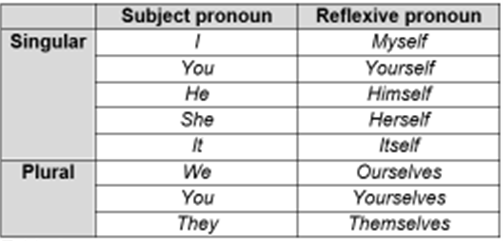I. WHAT ARE REFLEXIVE PRONOUNS?
We use pronouns when it is not necessary or possible to use a more exact noun phrase. Reflexive pronouns refer back to the subject.
For example:
- Ana taught herself to play the guitar. (“Herself” refers to the subject “Ana”. It is unnecessary to repeat “Ana”).
The reflexive pronouns are:

II. USING REFLEXIVE PRONOUNS
We use reflexive pronouns when:
- The object is the same person as the subject of a sentences.
For example:
- I accidentally cut myself while chopping the tomatoes.
subject object
- Roman and Oscar locked themselves out.
subject object
- We want to emphasize:
- That subject did the action and nobody or nothing else.
For example:
- I’ll talk to the CEO herself if necessary.
- The story itself is beautiful, but the acting could be better.
- That the subject did the action without help.
For example:
- I built the machine myself.
- Are you repairing the car yourself?
III. VERBS AND REFLEXIVE PRONOUNS
There are some verbs that do not usually take a reflexive pronoun. It might not be the same in your native language.
Look at these examples:
- Hurry
- Children we need to hurry, or we’ll miss the bus.
- Meet
- We’ll meet at the restaurant.
- Remember
- Remember to save the document.
- Sit down
- Everybody, sit down. We’re going to start the class.
- Wake up
- I am sorry. I woke up late and missed the train.
- Wonder
- I wonder when we are going to get the results.
- Worry
- Don’t worry. Everything is going to be fine.
However, the verbs change, dress and wash can take a reflexive pronoun if we want to stress that the action is difficult.
For example:
- My little brother broke his arm playing football. It takes him ages to dress and wash himself.
IV. COMMON EXPRESSIONS WITH REFLEXIVE PRONOUNS.
The following expressions use a reflexive pronoun.
- Behave yourself
For example:
- Please, children behave yourselves. We are in a library.
- Enjoy yourself
For example:
- They really enjoyed themselves at the party.
- Help yourself
For example:
- The food is ready. Help yourselves.
- Take care of yourself
For example:
- Have a good trip. Take care of yourself.
- Make yourself at home
For example:
- Please, come in and make yourself at home.
- By oneself
For example:
- I don’t want to talk to you right now. I’d like to be by myself.
V. THEMSELVES AND EACH OTHER
Can you see the difference between these two sentences?
- They are looking at themselves

- They are looking at each other.

When using “each other” or “one another” we say that the action is reciprocal. But not reflexive, back to the subject.
For example:
- Diana and Julieta are such good friends. They always help each other. (Diana helps Julieta and Julieta helps Diana).
- Steph and I are learning how to draw. To practice we draw each other. (Steph draws me and I draw Steph).
VI. CONSOLIDATION. NOW TRY THE FOLLOWING QUIZ.
VII. EXERCISE I.
VIII. PRACTICE I.
TORNADOES: WATCH OUT!
By Michael A. Signal. 2018.

Dark clouds loom overhead. Sheets of pounding rain pour down from them. Lightning sparks across the sky, and the roar of thunder is heard for miles. Hail pellets bounce off of cars and sidewalks. A severe thunderstorm like this is common in many parts of the country. Heavy rain, hail, and lighting from a thunderstorm can cause serious damage, but a thunderstorm can also lead to something much more menacing: a tornado. (1)
Tornadoes usually form from large thunderstorms. When the winds beneath a storm are unstable, they blow at different speeds. These unstable winds underneath the thunderstorm can begin to rotate. If that rotating air gets pushed up into the storm, it can gain strength and speed. A dark cone of air may swirl down from the storm. This is called a funnel cloud. If the funnel touches the ground, it becomes a tornado. (2)
Tornadoes can form very quickly. They create the strongest winds on the planet, with speeds that can top 200 miles per hour. In 1967, a powerful tornado struck Oak Lawn, Illinois. Patti Ernst lived through that tornado as a child. “Our garage blew away. Our car was crunched,” she remembered in an interview with Chicago television station. Still, she knew it could have been much worse. A powerful twister can rip houses from their concrete foundations and flatten whole neighborhoods. “My family was so lucky,” Ernst said. The Oak Lawn tornado destroyed over 100 homes, and it killed dozens of people. But survivors of 2011’s Joplin, Missouri tornado know that tornadoes can be much worse. Rance Junge described the tornado to ABC News. “You couldn’t see a funnel. It was just so massive,” he told reporters. (3)
Joshua Wurman is an atmospheric scientist who studies tornadoes. “For people to be safe from tornadoes, several things must happen,” Wurman explained in an interview with CNN. According to Wurman, the key to saving lives is to understand how tornadoes start. He says it is also important to learn which thunderstorms will spawn tornadoes and which ones will not. But predicting tornadoes is still tricky. Wurman is a leading tornado expert. He has spent decades studying the storms and even chasing them. (4)
It is also important to know what to do when a tornado touches the ground. Tornadoes can uproot trees, lift cars, and hurl smaller objects with fatal force. If a tornado hits, it is important to stay away from falling and flying debris. Some buildings and houses are equipped with safe rooms that are designed to withstand tornadoes. This is the safest place to be during a tornado. If a designated tornado shelter is not available, it is best to shelter in a room inside a sturdy building. Staying away from windows is a must. Airborne debris can smash through them and flying, jagged glass shards can be deadly. Ground floors are safer than being upstairs, and basements provide even better protection. (5)
In the United States, most tornadoes strike in “Tornado Alley.” This area stretches from Texas north to the Dakotas. People who live in this area know how to prepare for the dangers of tornadoes. They know to look for warning signs, like a strange quietness just after a thunderstorm, changes in the sky’s color, or the ominous sight of a funnel cloud. Many people have tornado shelters built on their properties or under their homes. They know the quickest routes to the safest areas in their houses, schools, and workplaces. Scientists will continue to get better at predicting tornadoes, but for now, being prepared for a tornado is the best way to stay safe. (6)
For each question or statement, mark the correct letter a, b or c.
IX BIBLIOGRAPHY
Berry, R. (2021). Case Study 1: The Articles. In Doing English Grammar: Theory, Description and Practice (Cambridge Applied Linguistics, pp. 147-167). Cambridge: Cambridge University Press. doi:10.1017/9781108325745.009
Cambridge University Press. (2005). Cambridge Advanced Learner’s Dictionary. Second Edition.
Eastwood, J. (2019). Oxford Practice Grammar. Intermediate. Oxford University Press.
Swan, M & Walter, C. (2016). Oxford English Grammar Course. Intermediate. Oxford University Press.
X WEB RESOURCES
Image 1. Free stock photos_https://www.pexels.com/es-es/foto/mujer-maquillaje-adentro-espejo-7576003/ by
Image 2. Free stock photos_https://www.pexels.com/es-es/foto/ordenador-portatil-mujer-navegando-internet-6954206/ by
Image 3. Free stock photos_ https://www.pexels.com/es-es/foto/relampago-y-tornado-golpeando-la-aldea-1446076/ photo by Lambrecht, Ralph.
XI CREDITS
- Practice exercise written by Xóchitl Adriana Hernández Martínez_FES Acatlán. UNAM
- Audio version performed by Kimberly_Voicemaker_Text to Speech Converter_ Xóchitl Adriana Hernández Martínez 2022
- Practice exercises written by Xóchitl Adriana Hernández Martínez_FES Acatlán.
- Signal, Michael. 2018. Text retrieved and adapted from_ https://www.commonlit.org/es/texts/tornadoes-watch-out/_Licensed under CC BY-NC-SA 2.0.
- Practice exercise written by_Xóchitl Adriana Hernández Martínez
- Audio version performed by Kimberly_Voicemaker_Text to Speech Converter_ Xóchitl Adriana Hernández Martínez 2022